Wrap It Up: The Masked Portraits of Ewa Juszkiewicz
Ewa (Millennial, Polish) is giving copycat. But there's a twist where feminism meets fabrics. Does it work, though?
It’s giving Bridgerton
Ewa reworks 18th and 19th century portraits of (mostly) noblewomen. Instead of staying 100% true to the original work and merely copying it, she hides the sitter’s face. Fabrics, laces, ribbons, plants, hairstrands and thick curls tightly wrap around the head, rendering the person underneath unrecognizable.
Ewa paints on raw canvas, often going for a larger format than the original. She combines three traditional genres of painting: Landscape, portrait, and still life. While 18th & 19th century portraits recurrently featured a landscape background, Ewa’s added plants and fruits tie the genres together. Traditionally, still life painting was on the lower part of the art hierarchy because you don’t need a lot of material to paint one. Some bread, a glass of wine and there you go. Exactly due to that accessibility, female painters went for this genre and were ironically discriminated against for the very same reason.
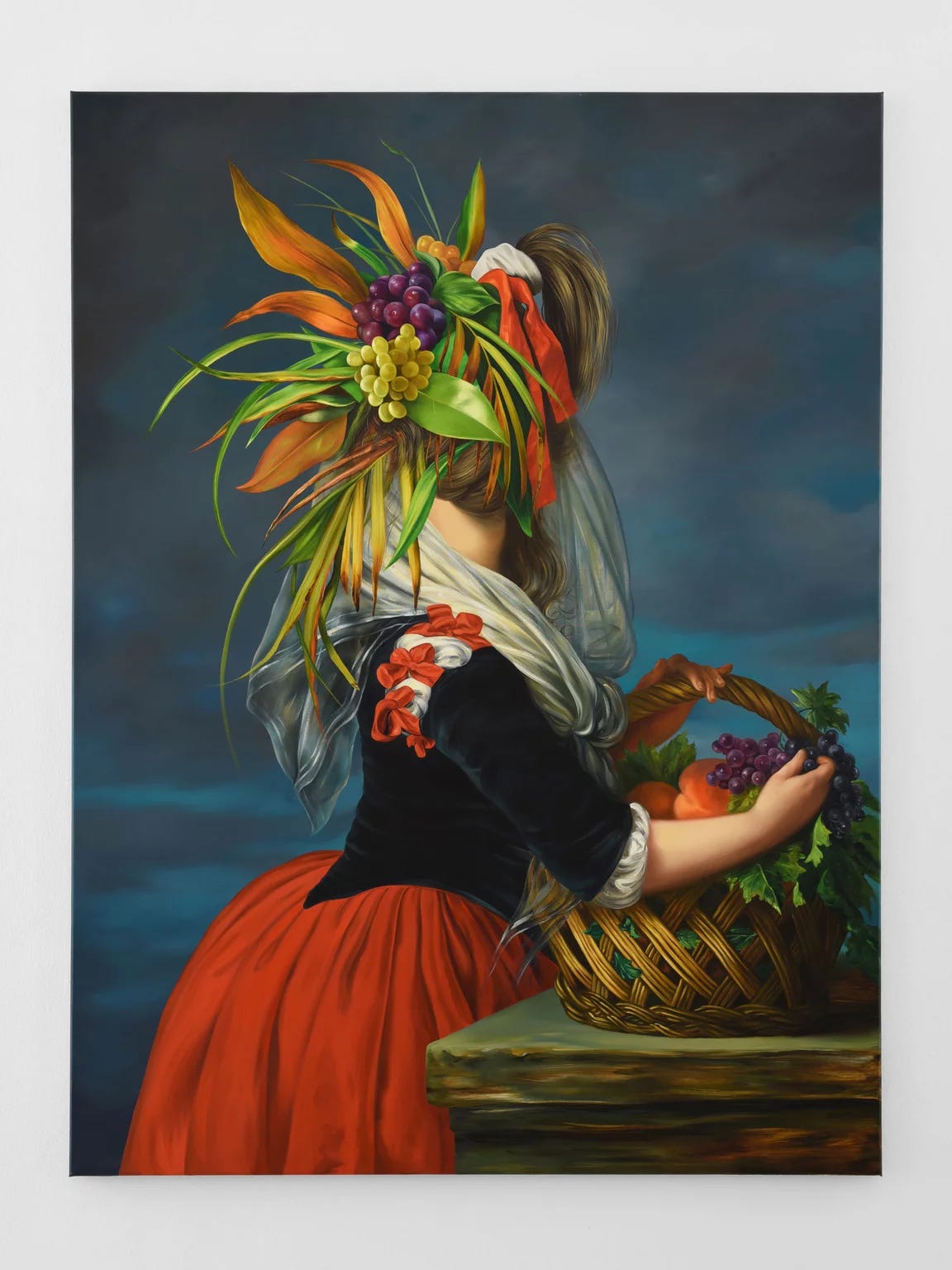
On the other hand, though, still life paintings could serve as pretexts to display lavish wealth: Say through exotic plants or tropical fruits. Ewa uses both plants appropriate for the climate of the original painting contexts and tropical ones. The women in the original paintings are thus decoration served on a nice plate, highlighted once more through her exaggerated use of ribbons and bouquets swirled around luxurious fabrics on the sitters’ faces.
According to the press release, Ewa looks to such fashion designers as Rei Kawakubo, Martin Margiela, Alexander McQueen, and Iris van Herpen. Respectable taste. Scrolling social media, I recently came across Vivienne Westwood’s summer ‘97 show “Vive La Bagatelle”: One design was a wedding gown with a flower bouquet cascading from the waist down. The model’s face was tied with a white ribbon as were her hands behind her back. Just like Vivienne, Ewa makes a point: The decorative is restrictive.
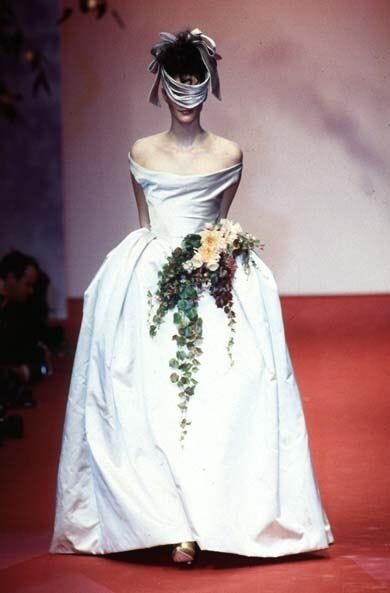
An art historical freestyle
Ewa isn’t the only artist twisting existing portraits or imitating aesthetics of artworks of past centuries. Titus Kaphar (Gen X, American) uses 18th and 19th century portraits of white nobility to question this Eurocentric genre. Mandy Racine (Baby Boomer, British) turns Rococo paintings into dripping street artsy versions while Flora Yukhnovich (Millenial, British) boils them down to flickering abstraction. Gemmy Woud-Binnendijk (Gen X, Belgian) translates Baroque aesthetics into photography and Romina Ressia (Millenial, Argentinian) breaks the illusion of a Baroque portrait by photographing her subjects with 21st century props.
In the past, artists loved sampling, too. The Balcony (1950) is Renée Magritte’s (1897-1967, Belgian) surrealist take on a work by Édouard Manet (1832-83, French), replacing the humans with coffins. What those artists do is either keep the content of that past period and change the style or imitate the style but change the contents. What’s the case with Ewa’s art?
There’s definitely something surreal about Ewa’s masked sitters. Especially Lady with a Pearl (after François Gérard) (2024) with its mountain of bright red fabric reminds me of Renée’s portrait of a couple kissing throgh veils, Lovers II (1928). But would Renée’s lovers be such an intriguing work of art if he made several of them? Different versions with changing fabric? I doubt it.
Where’s the technique?
All jokes aside, Guillermo Solana seriously wrote a great text for this exhibition. He draws compelling parallels to artistic traditions and brings Ewa’s work into striking art theoretical contexts. And yet, I have some issues with the results infront of me.
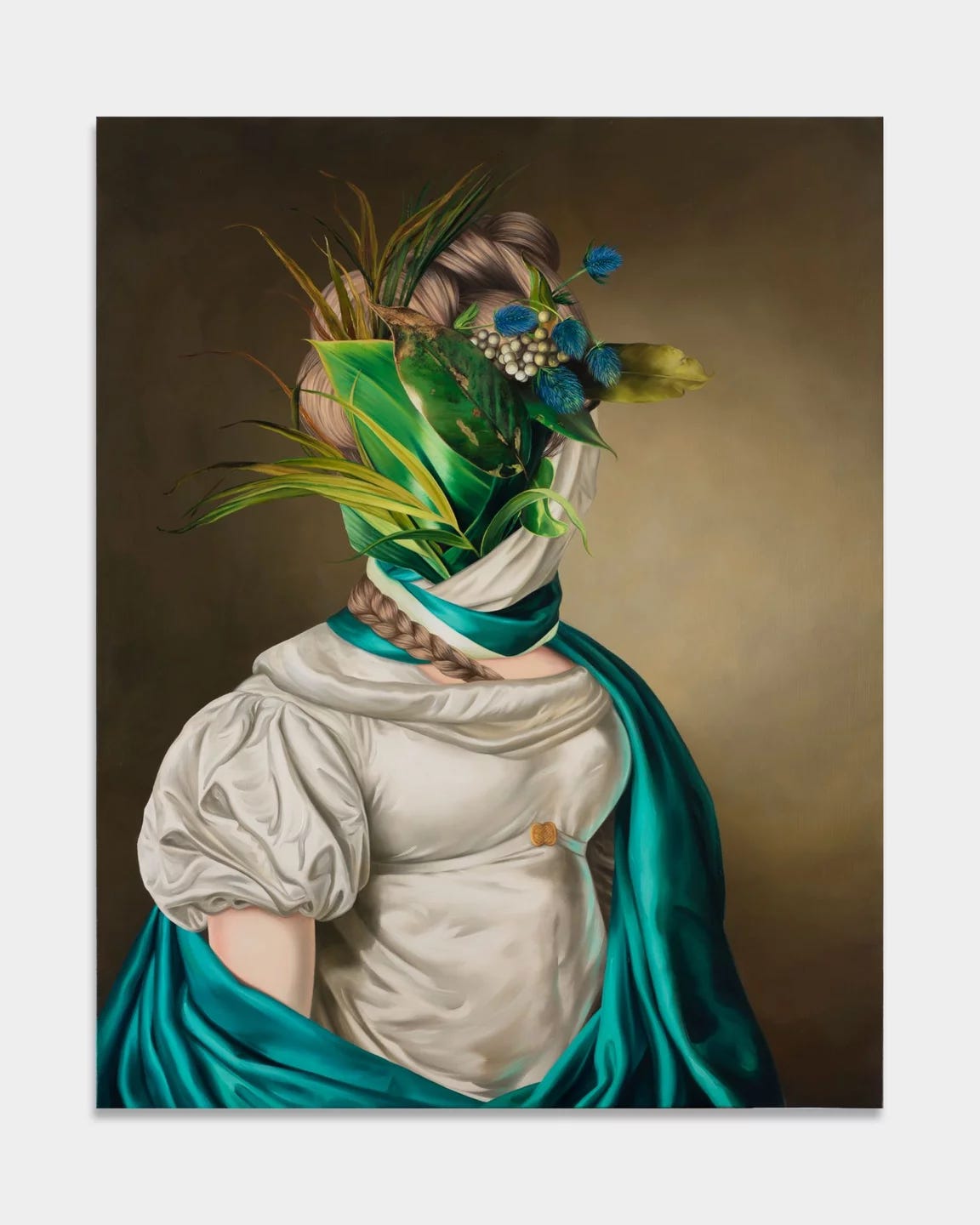
Guillermo argues that Ewa “cultivates a traditional pictorial craft, painting in layers, with many glazes, following the brushstrokes of the original work.” Oh really? Let’s go brush for brush then. Right after having had a close look at Ewa’s works, I headed straight to Galleria dell’Accademia and Ca’Rezzonico for cross references. And I went that extra mile and compared her works with close-ups of the originals she is refering to… Is the traditional pictorial craft in the room with us?
There isn’t much admirable mastery. It’s not like Ewa skillfully imitates the painting techniques of the 18th and 19th century. If she did, she would have added varnish as proper for those centuries. She only imitates the overal visuals. But looking closer, you see the brushwork is quite generic. Barely any differentiation of fabric texture. Take In a Shady Valley, Near a Running Water (after François Gérard) (2023) for instance. The black dress is so schematic that it looks stenciled rather than painted. The illusion of fabric doesn’t follow through in the white fringes at the seam because, compared to the original, the application is simply lazy.
Guillermo admires her “palette that is more vivid, and saturated, with a more luminous effect,” which is to me such an Americanized thing to say. In the States, “restoration” of paintings often means adjusting aesthetics to contemporary preferences. Saturated bright colours are among such preferences. While Ewa does amp up the saturation of the sitter’s teal shawl to the max in Portrait of a lady (after Christoffer Wilhelm Eckersberg) (2020), she makes a rookie mistake: There is absolutely no depth in the hair braid falling over her right shoulder. It rests flat. Compared to the delicate treatment of texture in the original, Ewa’s brushwork appears rather snotty.

Saving the damsel in distress
Ewa paints decent commercial art. It looks nice, it’s fun. Her Louis Vuitton collab proves her popularity in the upper paycheck circles. Arthistorically, though, there ain’t much to grab there. It’s like a joke told well once. The first time you hear it, you smirk (you might even let out a nose exhale), not necessarily a belly laugh, though. But after that one time, you already get it, you’re good. Like yeah, your first impression is a historical portrait, but then you notice hair and fabric covering the face and you go oh, this is in fact not an 18th century painting. It won’t get any better if you look at more works.
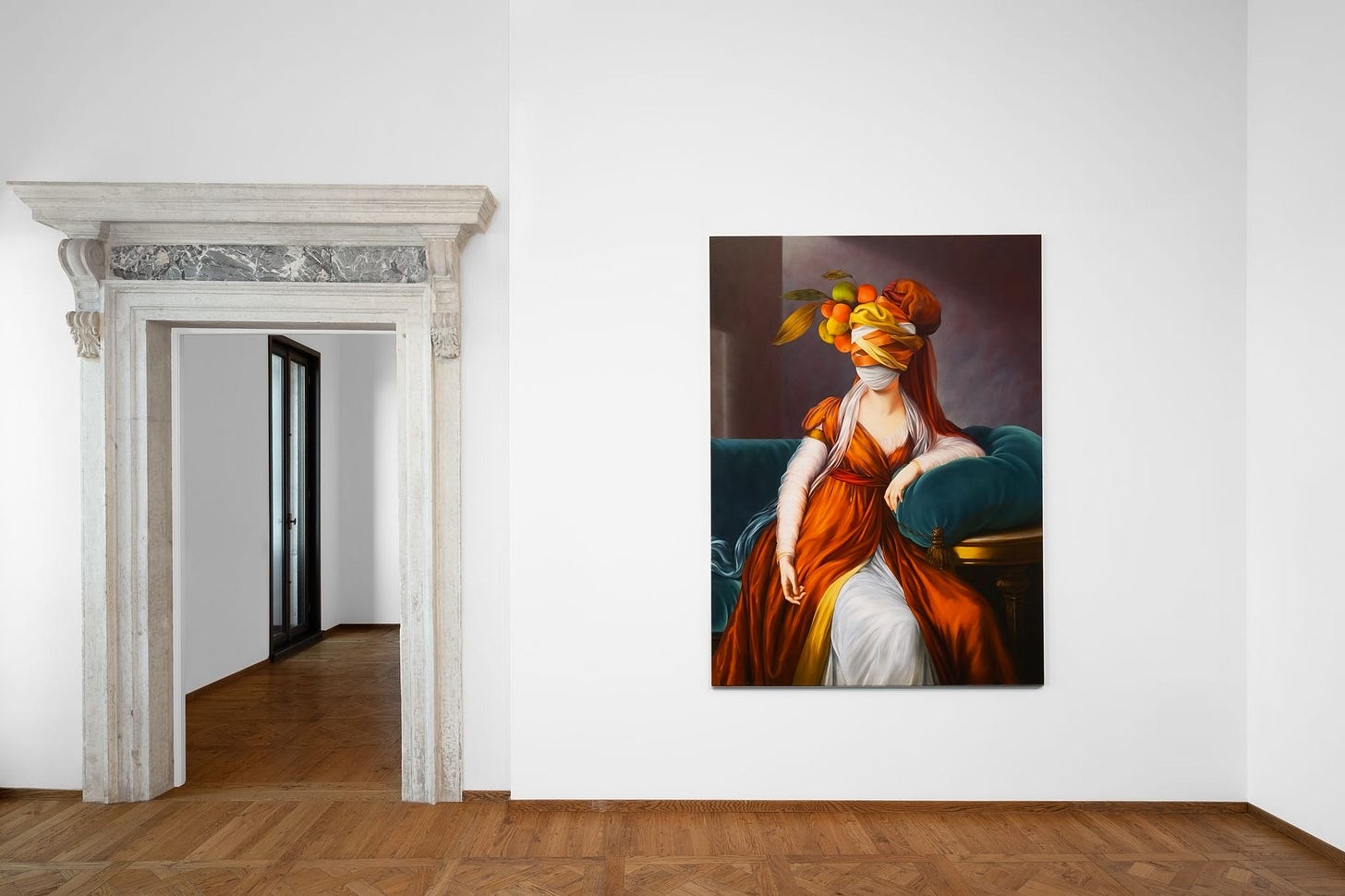
Conceptually, Ewa’s works are complex, but their execution is bland. According to Guillermo, “[h]er work is based on a genuine admiration for the painters she chooses, and an eagerness to rescue the painting of the past and bring it back to life.” Girl who are you trying to rescue? From what? Isn’t the idea of saving these works/portraits/sitters disempowering?
It would make sense if all chosen portraits were painted by men. But they aren’t. Ewa also freestyles on works of Élisabeth Vigée Le Brun (1755-1842, French), a prolific celebrity painter of the 18th century. In a past show, Ewa also made a riff on Adélaïde Labille-Guiard (1749-1803, French). Women artists painting other women is a form of keeping a record of their existence, resisting their eradication in a history of art dictated by men. Why hide them again? Where is the power? I don’t believe that “the female figures are liberated, emancipated from the patriarchal gaze.” Women were veiled and erased in art history for so long, I don’t think suffocating them under another layer of fabric helps.
Like don’t get me wrong, I love some good ol’ patriarchy-dragging in art. I’m not out here trying to be Drake or Kendrick competing for the title of the biggest hater. It’s just that I feel like I’m getting served sparkling wine but I’m told it’s champagne. WOW now that’s a pretentious analogy, I don’t even know where that came from.
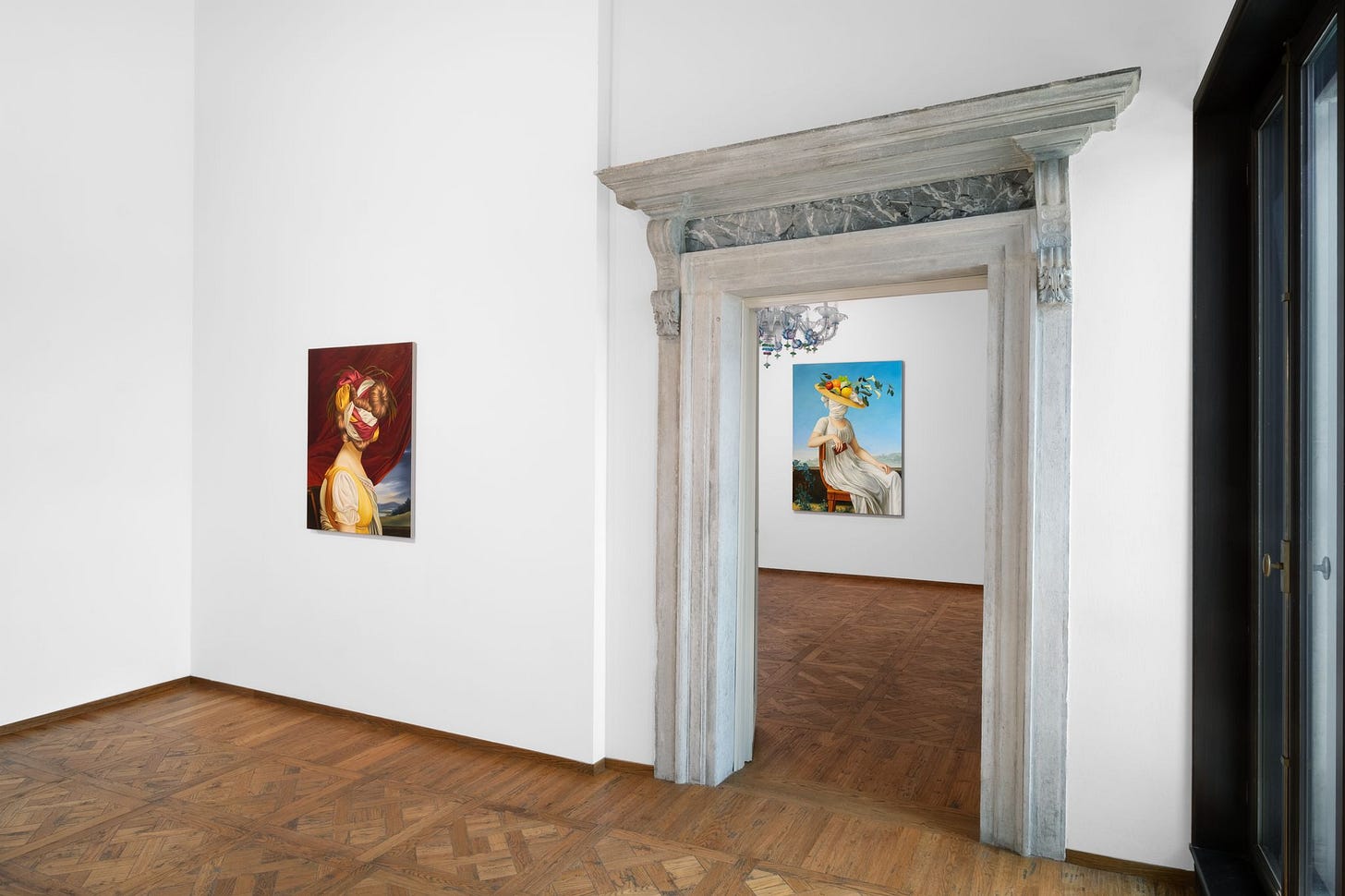
Money rules the world
I am disillusioned by the way things work in the art world. This is a Collateral Event of the International Art Exhibition (or colloquially, the Art Biennale) titled Stranieri Ovunque - Foreigners Everywhere. To become a Collateral Event, you need a) to be an NGO organizing the exhibition and b) the approval of the curator of the International Art Exhibition (this year, it’s Adriano Pedrosa).
Ewa is represented by mega-gallery Almine Rech which has a space at Venice’s Palazzo Cavanis. Exhibiting during the Biennale is already a boost, but if you have that red squared lion logo on your press material, best believe it will skyrocket your reach and prestige. Almine Rech can’t make a Collateral Event as a commercial gallery. But you know who can? FABA (Fundación Almine y Bernard Ruiz-Picasso). And with Almine Rech supporting the show, you get the best institutional visibility while also securing that bag (I noticed a couple of works not mentioning the ownership yet…).
Is this Foreigners Everywhere? No, rather the usual suspects all around.
Ewa Juszkiewicz: Locks with Leaves and Swelling Buds, Collateral Event of the 60th International Art Exhibition – La Biennale di Venezia, through September 1, 2024 at Palazzo Cavanis.
Palazzo Cavanis
Fondamenta Zattere ai Gesuati 920
30123 Venice
Website
Instagram: @ewa_juszkiewicz @alminerech
What do we think of these wrapped portraits? I’d love to read your thoughts in the comments. If you had fun reading this one, please leave a like and share with friends who might wanna see what’s going on artwise in Venice.
See you soon!!!
Jennifer
The Gen Z Art Critic




